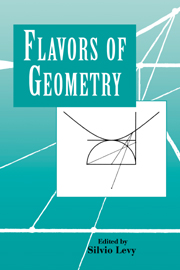Complex Dynamics in Several Variables
Published online by Cambridge University Press: 27 June 2025
Summary
1. Motivation
The study of complex dynamics in several variables can be motivated in at least two natural ways. The first is by analogy with the fruitful study of complex dynamics in one variable. Since this latter subject is the subject of the parallel lectures by John Hubbard (the reader is referred to [Carleson and Gamelin 1993] for a good introduction to the subject), we focus here on the second source of motivation: the study of real dynamics. A classical problem in the study of real dynamics is the n-body problem, which was studied by Poincare. For instance, we can think of n planets moving in space. For each planet, there are three coordinates giving the position and three coordinates giving the velocity, so that the state of the system is determined by a total of 6n real variables. The evolution of the system is governed by Newton's laws, which can be expressed as a first order ordinary differential equation. In fact, the state of the system at any time determines the entire future and past evolution of the system.
This question, in fact, particularly interested Poincare. Unfortunately, the usual answer to such a question is “I don't know.” Nevertheless, it is possible to say something useful about related questions, at least in some settings. For instance, one related problem is the following.
Say something interesting about the set of initial conditions for which the planets have bounded forward orbits.
Although this question is less precise and gives less specific information than the original, an answer to it can still tell us quite a bit about the behavior of the system.
Information
- Type
- Chapter
- Information
- Flavors of Geometry , pp. 117 - 150Publisher: Cambridge University PressPrint publication year: 1997
